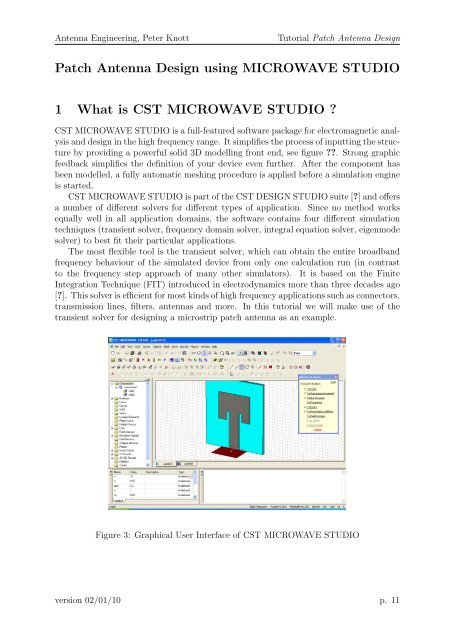
- CST MICROWAVE STUDIO PORT HOW TO
- CST MICROWAVE STUDIO PORT PATCH
In fact here the ground plane underneath the substrate has the same dimension as that of the substrate.
CST MICROWAVE STUDIO PORT PATCH
The substrate can have other dimension greater than the patch antenna size. The substrate has twice the width and length of the patch antenna, that is, 2W and 2L. W and L are the width and length of the patch antenna. The antenna that will be designed is shown in Fig 1. Readers can visit the first part or the third part below-ġst part- Patch antenna design with CST microwave (calculation of dimensions)ģrd part- Inset Fed Patch Antenna Simulation and Result In this part of the tutorial, we will use the dimension calculated in the first part to design the patch antenna in CST microwave studio. Please note that the actual course agenda may vary depending on location.This is the second part of the Inset fed Patch antenna design tutorial using CST Microwave Studio.

The overview provides details of the topics covered in each lecture.
Extract data from the standard result set through the use of post-processing templatesĮlectromagnetic Simulation Analysts. Analyze simulation results such as S-parameters, voltages, currents, 3D nearfields and farfields. Run Time-Domain (FIT) and Frequency-Domain (FEM) simulations including parametric sweeps and optimizations. Choose and set up the most appropriate solver and algorithm for high frequency applications. Setup result monitors to obtain 2D/3D field data. Setup excitations using lumped elements and waveguide ports. CST MICROWAVE STUDIO PORT HOW TO
Understand the various material types that exist and how to define them. Set up the project environment with the desired units, frequency settings, background materials and boundary conditions. Generate CAD geometries within the native modeling interface. Navigate the general layout of the CST Studio Suite interface. Upon completion of this course you will be able to: This course will also briefly discuss the various high frequency solvers available in CST Microwave Studio and provide a behind-the-scenes look at the FIT and FEM algorithms. Throughout this course you will become familiar with the CST Studio Suite interface and how to perform basic tasks in terms of modeling, setup of simulation, and analyzing pre and postprocessing results. Tire Analysis with Abaqus: Fundamentals. Tire Analysis with Abaqus: Advanced Topics. Substructures and Submodeling with Abaqus. Structural Scenario Creation Essentials. Structural Model Creation Geometry and Meshing. Structural-Acoustic Analysis Using Abaqus.  Obtaining a Converged Solution with Abaqus. Multiscale Experiment Creation Essentials. Modeling Rubber and Viscoelasticity with Abaqus. Modeling Fracture and Failure with Abaqus. Modeling Extreme Deformation and Fluid Flow with Abaqus. Modeling Contact and Resolving Convergence Issues with Abaqus. Mechanical Scenario Creation: Linear Dynamics. Mechanical Scenario Creation Essentials. Linear Structural Scenario Creation Essentials. Heat Transfer and Thermal-Stress Analysis with Abaqus. Getting Started with Automation and Optimization. FSI Simulation Using Abaqus and Third-party CFD Codes. Fitness-for-Service Analysis with Abaqus. CST Studio Suite - Vector Network Analyzer Training. CST Studio Suite - Photonics and Plasmonics.
Obtaining a Converged Solution with Abaqus. Multiscale Experiment Creation Essentials. Modeling Rubber and Viscoelasticity with Abaqus. Modeling Fracture and Failure with Abaqus. Modeling Extreme Deformation and Fluid Flow with Abaqus. Modeling Contact and Resolving Convergence Issues with Abaqus. Mechanical Scenario Creation: Linear Dynamics. Mechanical Scenario Creation Essentials. Linear Structural Scenario Creation Essentials. Heat Transfer and Thermal-Stress Analysis with Abaqus. Getting Started with Automation and Optimization. FSI Simulation Using Abaqus and Third-party CFD Codes. Fitness-for-Service Analysis with Abaqus. CST Studio Suite - Vector Network Analyzer Training. CST Studio Suite - Photonics and Plasmonics. 
CST Studio Suite - Microwave and Antenna. CST Studio Suite - Charged Particle Dynamics. CST Studio Suite - Advanced training on integral equation and asymptotic solvers. Connector Elements and Mechanism Analysis with Abaqus. Composites Simulation Engineer Essentials. Buckling, Postbuckling and Collapse Analysis with Abaqus. Automotive Powertrain Assembly Analysis with Abaqus. Analysis of Geotechnical Problems with Abaqus. Analysis of Composite Materials with Abaqus. Additive Manufacturing Scenario Essentials. Abaqus/CAE: Geometry Import and Meshing. Introduction to Abaqus/Standard and Abaqus/Explicit.







 0 kommentar(er)
0 kommentar(er)
